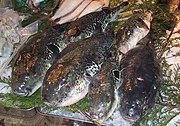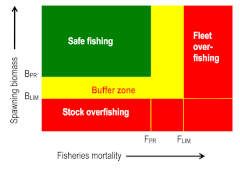Portal:Fish/Selected article
| This page is currently inactive and is retained for historical reference. Either the page is no longer relevant or consensus on its purpose has become unclear. To revive discussion, seek broader input via a forum such as the village pump. |
| Note: Article entries are now being transcluded directly on the main portal page. However, this page should be retained for historical reference. |
This is the archives for "selected article of the month" section in the fish portal.
Special notes
The layout design for these subpages is at Portal:Fish/Selected article/Layout.
- Each month, a new selected fish is added to the next available subpage. Please see the nomination and selection for this section here.
- When an article is added, update "max=" to new total for its {{Random portal component}} on the main page (this randomization feature will be implemented in the future when the fish portal has more articles).
"Selected article of the month" archive
Selected article 1
Portal:Fish/Selected article/1
Finding Nemo is an Academy Award-winning computer-animated film. Released in 2003, the movie set a record as the highest grossing opening weekend for an animated feature, making $70 million. It was, for a time, the highest grossing animated film of all time. It went on to become the best selling DVD of all time at 28 million copies sold.The film tells the story of a widowed clownfish named Marlin and his son Nemo who lives on the Great Barrier Reef, Australia. Other characters include Dory, a blue tang who suffers from short-term memory loss, Bruce, a good-hearted great white shark, and Crush, the sea turtle.
The film's prominent use of clownfish has wide effects including mass purchase of the animals for children's pets in the United States.
Selected article 2
Portal:Fish/Selected article/2
An aquarium (plural aquariums or aquaria) is a vivarium, usually contained in a clear-sided container (typically constructed of glass or high-strength plastic) in which water-dwelling plants and animals (usually fish, and sometimes invertebrates, as well as amphibians, marine mammals, and reptiles) are kept in captivity, often for public display; or it is an establishment featuring such displays. Aquarium keeping is a popular hobby around the world, with about 60 million enthusiasts worldwide. From the 1850s, when the predecessor of the modern aquarium was first developed as a novelty, the ranks of aquarists have swelled as more sophisticated systems including lighting and filtration systems were developed to keep aquarium fish healthy. Public aquaria reproduce the home aquarist's hobby on a grand scale — the Osaka Aquarium, for example, boasts a tank of 5,400 m³ (1.4 million U.S. gallons) and a collection of about 580 species of aquatic life, whilst the planned National institute for research into aquatic habitats in England would be at 40-hectares the world's largest aquarium.Selected article 3
Portal:Fish/Selected article/3
Fishing is the activity of hunting for fish by hooking, trapping, or gathering animals not classifiable as insects which breathe in water or pass their lives in water. By extension, the term fishing is applied to pursuing other aquatic animals such as various types of shellfish, squid, octopus, turtles, frogs, and some edible marine invertebrates. The term fishing is not usually applied to pursuing aquatic mammals such as whales, where the term "whaling" is more appropriate. Fishing is an ancient and worldwide practice with various techniques and traditions and it has been transformed by modern technological developments. In addition to providing food through harvesting fish, modern fishing is both a recreational and professional sport.Selected article 4
Portal:Fish/Selected article/4
The term painted fish refers to ornamental aquarium fishes which have been artificially coloured to appeal to consumers. This artificial colouring, also known as juicing, is achieved by a number of methods, such as injecting the fish with a hypodermic syringe containing bright fluorescent colour dye, dipping the fish into a dye solution, or feeding the fish dyed food.This process is usually done to make the fish a brighter colour and more attractive to consumers. The colouring of the fish is not permanent, and usually fades away in six to nine months. Painted fishes commonly found in the aquarium trade include Indian glassy fish, black tetra, oscar, Corydoras catfish and parrot cichlid.
Selected article 5
Portal:Fish/Selected article/5
Fish anatomy is primarily governed by the physical characteristics of water, which is much denser than air, holds a relatively small amount of dissolved oxygen, and absorbs light more than air does.Fish have a variety of different body plans. Their body is divided into head, trunk, and tail, although the dividing points are not always externally visible. The body is often fusiform, a streamlined body plan often found in fast-moving fish. They may also be filiform (eel-shaped) or vermiform (worm-shaped). Also, fish are often either laterally compressed (thin) or vertically depressed (flat).
Seen in this picture are (1) – operculum (gill cover), (2) – lateral line, (3) – dorsal fin, (4) – adipose fin, (5) – caudal peduncle, (6) – caudal fin, (7) – anal fin, (8) – photophores, (9) – pelvic fins (paired), (10) – pectoral fins (paired).
Selected article 6
Portal:Fish/Selected article/6
Fugu is a Japanese dish prepared from the meat of pufferfish (normally species of Takifugu, Lagocephalus, or Sphoeroides) or porcupinefish of the genus Diodon. Because pufferfish is lethally poisonous if prepared incorrectly, fugu has become one of the most celebrated and notorious dishes in Japanese cuisine.Pufferfish contains lethal amounts of the poison tetrodotoxin in the internal organs, especially the liver and gonads, and also the skin. Therefore, only specially licensed chefs can prepare and sell fugu to the public, and the consumption of the liver and ovaries is forbidden. But because small amounts of the poison give a special desired sensation on the tongue, these parts are considered the most delicious by some gourmets. Every year a number of people die because they underestimate the amount of poison in the consumed fish parts. The poison paralyzes the muscles while the victim stays fully conscious, and eventually dies from asphyxiation. There is currently no antidote, and the standard medical approach is to try to support the respiratory and circulatory system until the effect of the poison wears off.
Selected article 7
Portal:Fish/Selected article/7
A mermaid (from the Middle English mere in the obsolete sense 'sea' (as in maritime, the Latin mare, "sea") + maid(en)) is a legendary aquatic creature with the head and torso of human female and the tail of a fish. The male version of a mermaid is called a merman; the gender-neutral plural is merfolk or merpeople. Various cultures throughout the world have similar figures.Much like Sirens, mermaids in stories would sometimes sing to sailors and enchant them, distracting them from their work and causing them to walk off the deck or cause shipwrecks. Other stories would have them squeeze the life out of drowning men while trying to rescue them. They are also said to take them down to their underwater kingdoms. In Hans Christian Andersen's The Little Mermaid it is said that they forget that humans cannot breathe underwater, while others say they drown men out of spite.
The Sirens of Greek mythology are sometimes portrayed in later folklore as mermaid-like; in fact, some languages use the same word for both creatures. Other related types of mythical or legendary creature are water fairies (e.g. various water nymphs) and selkies, animals that can transform themselves from seals to humans.
Selected article 8
Portal:Fish/Selected article/8
Overfishing occurs when fishing activities reduce fish stocks below an acceptable level. This can occur in any body of water from a pond to the oceans. More precise biological and bioeconomic terms define 'acceptable level'.Biological overfishing occurs when fishing mortality has reached a level where the stock biomass has negative marginal growth (slowing down biomass growth), as indicated by the red area in the figure. (Fish are being taken out of the water so quickly that the replenishment of stock by breeding slows down. If the replenishment continues to slow down for long enough, replenishment will go into reverse and the population will decrease.)
Economic or bioeconomic overfishing additionally considers the cost of fishing and defines overfishing as a situation of negative marginal growth of resource rent. (Fish are being taken out of the water so quickly that the growth in the profitability of fishing slows down. If this continues for long enough, profitability will decrease.)
Selected article 9
Portal:Fish/Selected article/9
Fish and chips or fish 'n' chips, a popular take-away food, consists of deep-fried fish in batter or breadcrumbs with deep-fried potatoes, traditionally sold wrapped in newspaper.Popular tradition associates the dish with the United Kingdom; and for decades fish and chips dominated the take-away food sector in the United Kingdom, Australia, and New Zealand. Fish and chips also has considerable popularity in parts of North America (New England, the Pacific Northwest and Canada generally), the Republic of Ireland and South Africa. establishments in Denmark and in some coastal towns in Norway serve fried fillets. In the Netherlands, the popular deep-fried, battered fried fillet dish called lekkerbek sometimes served with chips.
The modern fish-and-chip shop originated in the United Kingdom, although outlets selling fried food occurred commonly throughout Europe. According to one story, fried-potato shops spreading south from Scotland merged with fried-fish shops spreading from southern England.
Selected article 10
Portal:Fish/Selected article/10
Deep sea fish is a term for fish that live below the photic zone of the ocean. Examples include the lanternfish, flashlight fish[disambiguation needed], cookiecutter shark, bristlemouths, anglerfish, and viperfishThe fish of the deep sea are among the most strange and elusive creatures on Earth. Since many of these fish live in regions where there is no natural illumination, they cannot rely solely on their eyesight for locating prey and mates and avoiding predators; deep sea fish have evolved appropriately to the extreme sub-photic region in which they live.
Many deep sea fish are bioluminescent, with extremely large eyes adapted to the dark. Some have long feelers to help them locate prey or attract mates in the pitch black of the deep ocean. The deep sea angler fish in particular has a long fishing-rod-like adaptation protruding from its face, on the end of which is a bioluminescent piece of skin that wriggles like a worm to lure its prey. The lifecycle of deep sea fish can be exclusively deep water although some species are born in shallower water and sink on becoming adults. Most bioluminescent color of their light is blue and some of them will produce red light.










